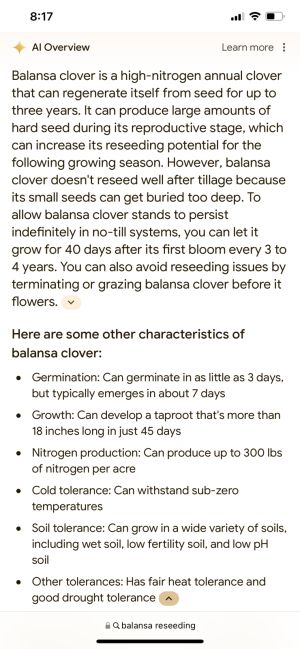Foggy47
5 year old buck +
Evidently more work to do on the no-till efforts up that way.
Evidently more work to do on the no-till efforts up that way.


Happy Peak Biological Nutrient Accumulation Day all you weirdos. Hope you've all got air, water, and moisture, and may the system do the rest.Happy Peak Biological Nutrient Accumulation Day all you goofy regen'ers.
View attachment 53728
View attachment 53729
Any change in conditions will bring different things to life. I'm not sure if you're talking past food plot seeds, or wild cards from the seed bank. I haven't seen horsetail in three years, and now it's everywhere because of the water. I've never had daisey and hawkweed, it's showed up now. None of them really bother me at this point. I think they'll all go away when conditions return to something closer to normal as long as I let the system keep advancing.SD I am curious do you believe that all this rain could have germinated seeds from past seedings or would they have burried to deep
Happy Peak Biological Nutrient Accumulation Day all you weirdos. Hope you've all got air, water, and moisture, and may the system do the rest.
I don't have a peak pic yet. Might get out there sunday to look around. I've swung from the driest I've ever been to the wettest I've ever been in two months. Looking forward to seeing the landscape.





As soils are compacted - or not flocculated due to inadequate CA base saturations, you can reduce air and water flow in the soil. This is why often when liming we focus on PH but should also look at Ca to Mg base saturations for chemical soil structure. As we have better chemical structure of soils, and use processes that’ll stimulate good biology - you’ll also see better soil aggregation and increases in soil aggregation.SD. What a video. Horse tails and thistle are showing a lack of ph mining it back up. For $200 you gain a lot of knowledge for 200 psi. I guess my biggest question is compaction of soil and soil microbes as the video ended. Please explain
HOPE THIS HELPS? Yeah....helps to confuse me more and more. I'm still at NPK and Organic Matter and Acidity. You guys are about two light years ahead of my brain on these issues. Fascinating stuff....but one can only can absorb so much at a time. Will any of this stuff be in the test? grin.As soils are compacted - or not flocculated due to inadequate CA base saturations, you can reduce air and water flow in the soil. This is why often when liming we focus on PH but should also look at Ca to Mg base saturations for chemical soil structure. As we have better chemical structure of soils, and use processes that’ll stimulate good biology - you’ll also see better soil aggregation and increases in soil aggregation.
Neil Kinsey and Dr. William Albretch are great resources for this info as well.
Hope this helps.
The test comes when the conditions slip away from favorable.HOPE THIS HELPS? Yeah....helps to confuse me more and more. I'm still at NPK and Organic Matter and Acidity. You guys are about two light years ahead of my brain on these issues. Fascinating stuff....but one can only can absorb so much at a time. Will any of this stuff be in the test? grin.
gypsum is a many splendored thing.......As soils are compacted - or not flocculated due to inadequate CA base saturations, you can reduce air and water flow in the soil. This is why often when liming we focus on PH but should also look at Ca to Mg base saturations for chemical soil structure. As we have better chemical structure of soils, and use processes that’ll stimulate good biology - you’ll also see better soil aggregation and increases in soil aggregation.
Neil Kinsey and Dr. William Albretch are great resources for this info as well.
Hope this helps.
It’s fantastic. I recall reading about Ben Franklin using it on his alfalfa. He recorded the alfalfa seemed “sweeter” for this cattle. Likely this was due to the clay flocculation and allowing for alfalfa to increase rooting depth. Better CA uptake and microbial flow through the soil profile. Atleast that’s my guess!!gypsum is a many splendored thing.......
bill
Found a good talk on soil air from a name I'd not seen mentioned yet. Glen Rabenberg from eastern South Dakota. There's quite a bit of info in this one that's not been mentioned anywhere else I've seen. One tidbit I picked up was an association between foxtail and compaction, thistle and compaction, and compaction and low calcium. There in lies the connection between gypsum and compaction. Lots of talk about penetrometers. I'm somewhat curious about what my soils would show using a penetrometer, but I'm not $200 curious. I know I've got some where that thing wouldn't go a few inches, and others I think might go quite deep.
Anyway, if you are a nerd, this is a good watch. Well produced, good speaker, good info.
